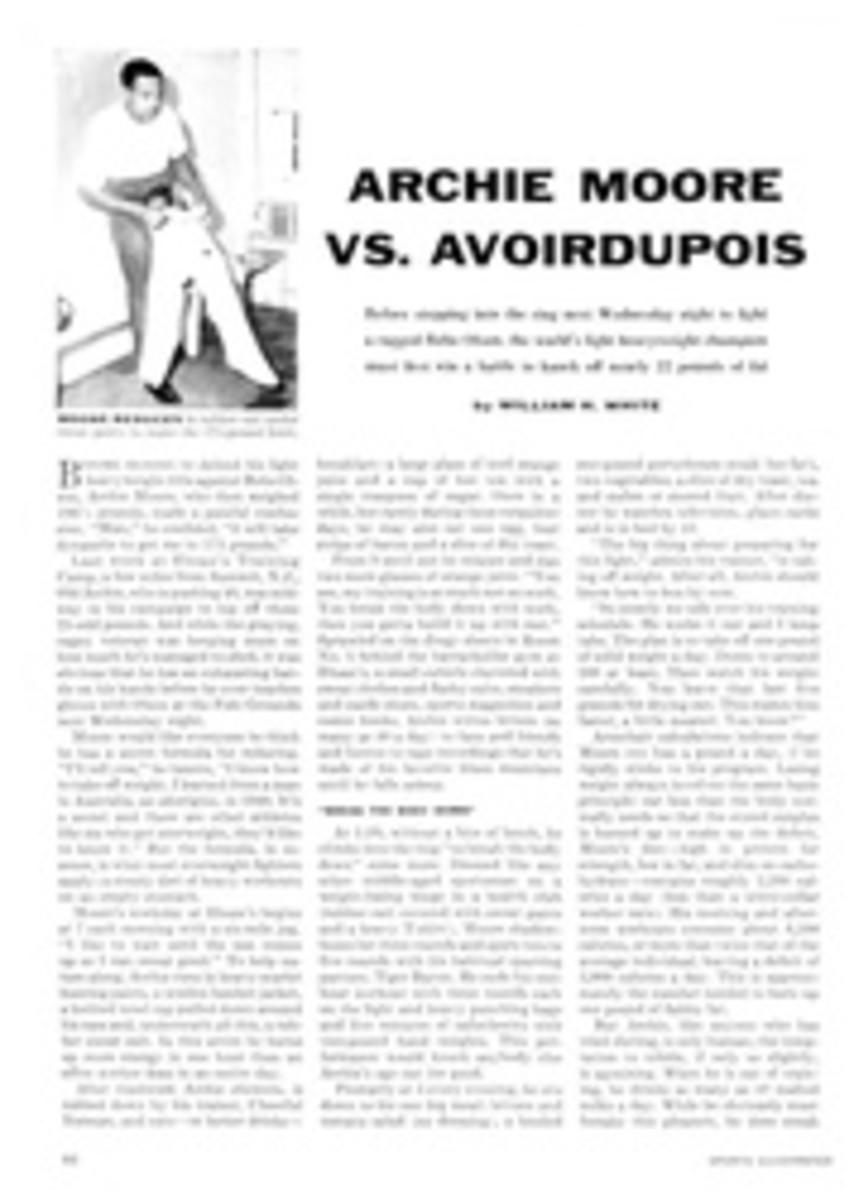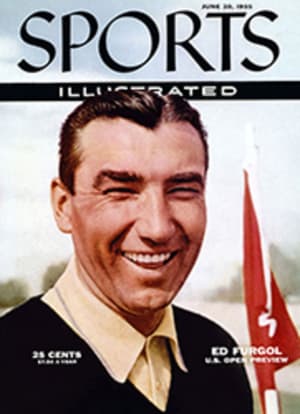
HARRIMAN AT YALE
The head coach of the Yale crew in 1913 was a dedicated, studious undergraduate who had never rowed in a varsity shell—and who happened to be the wealthiest student in any college in the U.S. He was cited by Bob Cook, Grand Old Man of Yale rowing, as "easily the most promising crew coach in America." "I hope," added Cook, "that he can give his life to it." He was referring to a young Yale senior named W. Averell Harriman.
Harriman, today the governor of New York State, did not give his life to rowing, but he did spend five years getting ready for his coaching career and the annals of his preparation are impressive.
They begin in June 1908, when E. H. Harriman, who owned or controlled a 23,000-mile railroad empire worth $1,500 million, loaded his two sons, Averell and Roland, aboard his three-masted, 190-foot steam yacht Sultana and sailed up the Hudson River to Poughkeepsie for the annual four-mile race of the Intercollegiate Rowing Association. Averell was then a member of the Groton School crew, and E.H.'s purpose was to find, and hire, the best rowing coach in the country to tutor his two sons that summer on the lake of his 20,000-acre estate at Arden, N.Y.
In an upset, a Syracuse eight, coached by Jim Ten Eyck and stroked by his son, defeated a highly favored Cornell crew. Ten Eyck went to Arden and for a month taught the refinements of single and double sculling to Averell and Roland. By the time Averell made the Yale freshman crew in 1910, he had a polished rowing style but could get his weight up to 160 pounds only with difficulty. Denied the rigors of an eight-oared shell by order of his doctors, Averell took up double sculling in his sophomore year with Jack Appleton (son of the publisher and now a vice-president of the Pennsylvania Railroad) as a partner.
At the end of the 1911 season Yale rowing was at the bottom. It had suffered four straight varsity defeats by Harvard. A despairing graduate rowing committee figured that any change at Yale would be for the better. For one thing there was a move to abandon professional coaching. English universities long had insisted on amateur coaches and would not allow professionally coached American eights to compete with them at Henley.
Then there was a debate over rowing styles. Most American crews were using a short, choppy stroke with a slow catch and a quick recovery. It was with this stroke that beefy Harvard eights were beating Yale with monotonous regularity on the Thames River at New London, Conn., where The Boat Race has traditionally been held since 1878.
On another Thames River at London, England, Oxford and Cambridge had for years been rowing in a very different way. The English stroke was a long, swinging one which, properly executed, gave more power and speed with fewer strokes per minute. Perhaps there was something to be learned on the Thames over the ocean that could put an end to the Crimson dominance.
The decision in favor of amateur coaching was made, and Averell Harriman was picked to coach the freshman crew for the 1912 season. In the winter of that year the young junior wangled a leave of absence from his classes and sailed for England and shortly arrived at Oxford with letters to Professor G. C. Bourne, Oxford coach and to the president (captain) of the Oxford University Boat Club.
Arriving at Oxford in an early spring drizzle, Averell found his way to the boathouse where he waited outside an open door in the rain while a boatman went up to the dressing room to fetch the Oxford captain. In his own good time that gentleman came down dressed in a great white duffle coat, stood in the rain with Harriman, read and then quizzically reread the letter of introduction. Governor Harriman recalls its key sentence: "Harriman has come from Yale, which is 3,000 miles away, to see you row." The captain crumpled the letter into a ball, stuffed it in his pocket and said, "We'll be going down the river shortly. If you walk along the towpath, you will be able to see us." He left Harriman standing in the rain.
Oxford's preparation for the annual race with Cambridge fell into three stages. It began at Oxford where Coach Bourne would pick the eight best men from the various college boats and get them started rowing together in one shell as a university (varsity) eight. This stage Averell watched from the towpath.
The crew then moved to Henley on the Thames for three weeks under a second coach, Holland, who got rid of each man's rough edges. There Harriman rode along the river on horseback beside Holland and learned the intricacies of the English stroke.
He lived at the Leander Boathouse with the crew. Night after night he dined silently and quite alone at a table separated from the one where the Oxford crew and coaches were seated. At the end of a week of observation, the president of the Oxford boat club rose, walked across to Harriman's table and asked him if he would like to dine with the crew. Thus, finally, and formally introduced, Averell got on famously with the Oxonians and joined them at meals and in their weekly glass of champagne. That introduction to British manners and character was not forgotten on later trips to England (as World War II Lend-Lease boss and postwar Ambassador to the Court of St. James's).
From Henley the crew moved down river to Putney for the final training period under still a third coach—Harcourt Gold, who had been a great Oxford stroke for three years and whose job now was to make the eight men row and compete as one.
The temptation to stay in London an extra week and see the race itself (which Oxford won for the fourth year in a row) was so great that Averell had booked passage back to the States on two steamers sailing a week apart. But his conscience won out, and he sailed before the race on the Olympic. He cancelled his reservation on the Titanic, which ran into an iceberg at full steam and sank on April 15, 1912 with a loss of more than 1,500 lives.
The Yale freshman crew of 1912 to which Harriman taught the English stroke lost to the Harvard freshmen at New London by a few feet, but they regularly beat their own varsity crew, and Averell was appointed coach of the varsity for the following year. In the winter of 1913 he went back to Oxford with Bud Snowden, the Yale captain, and Jim Rodgers, formerly Yale's head coach, who had become Harriman's advisory coach.
On returning to New Haven Harriman would arrive at 1:30 every day, rain or shine, at the George Adee Memorial Boat House in the harbor to drill his crews from a launch or even from a single scull, which he would row ahead of them, frequently until dark. He would then return to the training table for dinner with the crews and later would climb the four flights to his top floor room in venerable Connecticut Hall and dig into his books.
Harriman had won the graduate rowing committee over to English ways, and Harcourt Gold, accompanied by G. S. Maclagan, former Oxford coxswain, was brought over from Oxford in June 1913 to put the finishing touches on the Yale crew at Gale's Ferry in New London for the Harvard Race. At that time, Harriman also appointed another undergraduate to coach the freshman crew in the English style—a young man by the name of Dean Acheson. The Elis even rowed in a U-shaped English shell side-rigged so that the port and starboard oarsmen sat on alternate sides of the keel.
Despite all Yale's work on the new stroke, Harvard won every race at New London in 1913. Although they led at two miles, the Yale varsity oarsmen were beaten by 10 lengths at four miles. The light (151 pounds) stroke, Bill Crocker, could barely keep the Yale boat up to 29 strokes a minute at the finish; Harvard crossed the line at 38. It was Yale's seventh loss to Harvard in eight years and their sixth in a row. Reported the New York Times: "The annual regatta has become a Harvard holiday."
Although Harvard had tried the English stroke under an English coach in 1897 with disastrous results, Harriman would not give up after only a year's trial in 1913. At his insistence Guy Nickalls was brought over from Oxford to succeed Harriman as head coach at Yale in 1914 (he remained through 1921).
In 1914 the English experiment paid off. Stroked by Harriman's old doubles partner Jack Appleton and with all Harriman-and Acheson-trained men in the shell, the Yale varsity beat Harvard by a whisker. In 1915, still rowing the English stroke, Yale swept the river clean. The Blue varsity beat the Crimson by seven lengths.
PHOTO
SLENDER HARRIMAN WAS TOO LIGHT TO MAKE YALE VARISTY CREW
PHOTO
FRESHMAN COACH,young Dean Acheson was appointed by Harriman in 1913.
PHOTO
OXFORD EXPERTS Harcourt Gold (right) and G. S. Maclagan were brought to this country by Harriman to help coach varsity.

